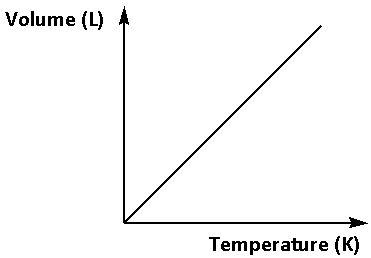
State Charle’s law. Also show the graph.
Answer
473.7k+ views
1 likes
Hint: The Charle’s law is derived and stated from the ideal gas equation. To solve this we must know the ideal gas law. The ideal gas law states for a given mass of an ideal gas and a constant volume of an ideal gas, the pressure exerted by the molecules of an ideal gas is directly proportional to its absolute temperature.
Complete step by step answer:
We know that the expression for the ideal gas law is as follows:
Where,
From the expression for the ideal gas law we can see that the volume of the gas is directly proportional to the temperature of the gas. The same is stated by Charle’s law.
The Charle’s law states that the volume of any gas is directly proportional to the temperature of the gas on the Kelvin scale under the same amount of pressure.
The expression for Charle’s law is as follows:
Where
The Charle’s law states that the volume of any gas is directly proportional to the temperature of the gas on the Kelvin scale under the same amount of pressure. When we plot volume versus temperature the graph is a straight line passing through origin.
Thus, the graph of Charle’s law is as follows:

Note:The application of Charle’s law in daily life is the floating hot air balloon in air. The air in the balloon is heated by a torch. This makes the air particles move faster and disperse thus, making the air in the balloon less dense than the air in the surrounding so that the balloon floats.
Complete step by step answer:
We know that the expression for the ideal gas law is as follows:
Where,
From the expression for the ideal gas law we can see that the volume of the gas is directly proportional to the temperature of the gas. The same is stated by Charle’s law.
The Charle’s law states that the volume of any gas is directly proportional to the temperature of the gas on the Kelvin scale under the same amount of pressure.
The expression for Charle’s law is as follows:
Where
The Charle’s law states that the volume of any gas is directly proportional to the temperature of the gas on the Kelvin scale under the same amount of pressure. When we plot volume versus temperature the graph is a straight line passing through origin.
Thus, the graph of Charle’s law is as follows:

Note:The application of Charle’s law in daily life is the floating hot air balloon in air. The air in the balloon is heated by a torch. This makes the air particles move faster and disperse thus, making the air in the balloon less dense than the air in the surrounding so that the balloon floats.
Recently Updated Pages
Master Class 9 General Knowledge: Engaging Questions & Answers for Success

Master Class 9 English: Engaging Questions & Answers for Success

Master Class 9 Science: Engaging Questions & Answers for Success

Master Class 9 Social Science: Engaging Questions & Answers for Success

Master Class 9 Maths: Engaging Questions & Answers for Success

Class 9 Question and Answer - Your Ultimate Solutions Guide

Trending doubts
State and prove Bernoullis theorem class 11 physics CBSE

What are Quantum numbers Explain the quantum number class 11 chemistry CBSE

Who built the Grand Trunk Road AChandragupta Maurya class 11 social science CBSE

1 ton equals to A 100 kg B 1000 kg C 10 kg D 10000 class 11 physics CBSE

State the laws of reflection of light

One Metric ton is equal to kg A 10000 B 1000 C 100 class 11 physics CBSE




